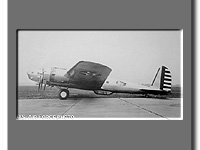
|
Description
| Manufacturer: | Boeing |
| |
| Base model: | B-17 | ||
| Designation: | B-17 | ||
| Version: | C | ||
| Nickname: | Flying Fortress | ||
| Designation System: | U.S. Air Force | ||
| Designation Period: | 1924-Present | ||
| Basic role: | Bomber | ||
| Crew: | 6 | ||
Specifications
| Not Yet Available |
Known serial numbers
Recent comments by our visitors
| Jack L Gilbert Rio Rancho, NM | B-17C can be visually differentiated from a B-17D by the lack of cowl flaps on the C model. 02/26/2009 @ 15:20 [ref: 23819] |
| Colin Benson Mackay, Queensland, TX | (It is not possible to enter the name of a state other than those listed!)
On 14th June 1943, B-17C, #40-2072, crashed soon after take-off before dawn from Mackay airport (Queensland, Australia) at 6.02 a.m. Forty of the 41 U.S. servicmen aboard were killed. The Bakers Creek Memorial was unveiled on 11th May 1992 to honour those men who died on Australian soil. The plane was en-route to Port Moresby, New Guinea, taking them back to their units after they had spent 10 or more days on R&R in Mackay. Mackay had been set up as an R&R centre in January 1943, and GIs came to Mackay on leave until at least October 1944. Annual commemorative ceremonies have been held since the Memorial was unveiled. On 4th June 2000, the U.S. Air Force returned to Mackay for the first time in 57 years to participate in commemorative ceremonies. The CS USAF, General Mike Ryan was represented by Col Rick Lester USAF, US Air Attache to Australia, and the Commander U.S. 5th AF, Lt Gen Paul V. Hester in Japan was represented by Colonel Timothy G. Murpy USAF. In January 1992 a story about the crash and the Memorial was published in the Times News Record in Wichita Falls. Chief Master Sergeant Teddy Hanks USAF (ret.) realised the crash was one in which he lost four fellow airmen while he was serving in New Guinea. As only the names of the crew and the sole surivor were known, Teddy began research to find the complete list of casualties. An official list was never released and the only comprehensive details about the incident are in a Queensland civil police report commissioned bythe US Army. As General Hester found in 2000, official U.S. records contain little about the crash. At the time it was the worst was the worst in U.S. transport history, and remains Australia\'s worst. It was also the worst in trhe Pacific theatre of WWII and the worst of 12,731 B-17\'s manufactured. Later in 1992, I crossed paths with Teddy Hanks paths over this research, and we have been working together ever since. On 14th June 1995, after much hard work by Teddy in tracing the casulaties a re-engraved plaque was unveiled with all names. As we discovered families had never learned anything about the crash, we sought to trace the final resting places of the victims and to inform close family members where possible. This has been a difficult and time consuming task. Until recently, we had located 22 headstones and 15 close relatives. In late 2000, General Hester was asked to help out. Through his efforts, further service information has recently been obtained. Already, this has led to contact with six more fmailies. We are hopeful of tracing all by the 60th Anniversary of the crash on 14th June 2003. We hope there will be a U.S. military representative at this year\'s ceremony, on 14th June 2001, the US Army\'s 225th birthday. For the 60th Anniversary of the crash, U.S. veterans who operated the plane with USAAF 46th Troop Carrier Squadron are planning to unveil a 6ft wingspan (bronze or fibre-glass) model of the plane. Sponsors / donations are needed. This B-17C flew with others to the Philippines in late 1941 and was one of the few planes to escape damage in Japanese raids a few hours after Pearl Harbour was attacked (8th December Philippine time). It escaped to Australia from where missions over 1100 miles were made to bomb the advancing Japanese. On 24th December 1942, it was severely damaged by flak and attacking fighters, managing to fly back to Batchelor Strip, south of Darwin, Australia, where it was written off as a combat plane. It was eventually repaired, in early January 1942 when the need for aircraft became desperate, and used as to transport troops and munitions to New Guinea. It was subsequently used on the R&R run between Port Moresby and Mackay, possibly around March 1943. Only one photograph of poor quality of this plane is known to exist, taken in August 1942. Any others are sought, along with permission to use for honourable anbd charitable purposes. Details of my research and activities relating to the Bakers Creek Memorial to men who aboard B-17C 40-2072 can be found at I am the POC in Australia. Col Benson Mackay, QLD. AUSTRALIA 04/10/2001 @ 23:40 [ref: 2052] |
Recent photos uploaded by our visitors








